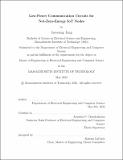| dc.contributor.advisor | Chandrakasan, Anantha P. | |
| dc.contributor.author | Jung, Jaeyoung | |
| dc.date.accessioned | 2022-08-29T16:31:22Z | |
| dc.date.available | 2022-08-29T16:31:22Z | |
| dc.date.issued | 2022-05 | |
| dc.date.submitted | 2022-05-27T16:19:19.571Z | |
| dc.identifier.uri | https://hdl.handle.net/1721.1/145077 | |
| dc.description.abstract | While Internet of Things (IoT) devices are increasingly widespread thanks to the lower cost of semiconductors, the reach of IoT is limited by the fundamental need of IoT devices for power. Currently, IoT devices are powered by a battery, which must be periodically replaced or recharged, or powered from the electrical grid, which limits mobility and requires a permanent wired connection. This thesis presents a solution in the form of the Net-Zero-Energy Device, an IoT node that can power itself by harvesting energy from 5G radiation. To transmit data from weak 5G signals, the energy harvester was optimized for sensitivity, and the active blocks were optimized to minimize their leakage power. The focus of this thesis is the design of the encoder block and backscatter circuit, which enable the IoT node to transmit data. | |
| dc.publisher | Massachusetts Institute of Technology | |
| dc.rights | In Copyright - Educational Use Permitted | |
| dc.rights | Copyright MIT | |
| dc.rights.uri | http://rightsstatements.org/page/InC-EDU/1.0/ | |
| dc.title | Low-Power Communication Circuits for Net-Zero-Energy IoT Nodes | |
| dc.type | Thesis | |
| dc.description.degree | M.Eng. | |
| dc.contributor.department | Massachusetts Institute of Technology. Department of Electrical Engineering and Computer Science | |
| mit.thesis.degree | Master | |
| thesis.degree.name | Master of Engineering in Electrical Engineering and Computer Science | |
